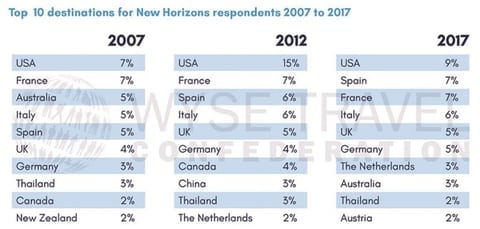From experiential happen to be the rise of Gen Z, a fresh report supplies a amount of updates on six trends reshaping the travel industry. “New Horizons IV: A worldwide study of the youth and student traveler” is founded on the New Horizons Survey, that is conducted by WYSE Travel Confederation every five years. In 2017, the survey attracted a lot more than 57,000 responses from 188 territories and countries. Listed below are updates on six Millennial and Gen Z travel trends from the report:
1. Travel Splurging
When the brand new Horizons Survey asked millennial and gen Z travelers what these were ready to splurge on throughout their trips, these were clear on the preference for experiential purchases. Thirty-seven percent of respondents were ready to shell out supplemental income for refreshments experiences. Traditional travel luxuries, such as for example airfare upgrades, were favored least.
The survey also showed a 26 percent jump from 2012 in the amount of activities young travelers undertake during a destination. Adding unique, one-of-a-kind experiential elements to the essential travel journey may be more productive than attempting to develop premium travel products targeted at Millennials, the report suggests.
Travel Industry Exchange
The #1 Industry Event for Specialization | Oct. 9-11, 2018
Travel Industry Exchange may be the leading one-to-one event having a product-focused conference, entertainment and networking. Top agents vie for coveted hosted positions to leverage valuable supplier content that can help improve personal growth and increase overall sales.
2. Growing Information Intensity and Usage of Online Travel Agencies (OTAs)
The true amount of different information sources used to analyze the primary trip has climbed steadily, from three in 2002 to a lot more than 10 in 2017. Family and friends were probably the most used information sources in 2017 still, but the need for social comparison and media or referral websites grew significantly from 2012.
More information has been gathered online at the expense of face-to-face interaction or printed information sources. About ten years ago, physical travel agent offices took over 70 percent of youth travel bookings – in 2017 a lot of this continuing business had shifted online, either to suppliers or via OTAs directly.
New booking and media platforms will undoubtedly be crucial travel planning resources for another generation of youth travelers, Generation Z, based on the report. These digital natives have become up with smartphones and Wi-Fi and so are significantly less more likely to use tourist information offices and tour operator brochures. Nearly three-quarters of Gen Z respondents made a minumum of one booking via smartphone in 2017.
3. Top Destinations for Young Travelers
Although the very best destinations remain exactly like in 2012 and 2007 largely, several noteworthy shifts are revealed from the 2017 New Horizons Survey. As the remains the most notable destination for young travelers, it lost a few of its share from 2012. Also, returned into the top 10 for the very first time in ten years.
According to the report, teenagers are interested to go to the united states still, but are deciding to explore other less-visited destinations also. Given the slight decline in long trips of 120+ days and a rise in shorter trips, long-haul destinations shall have to start rethinking how to build young travelers undertaking longer stays for study, working holidays, au pairing, along with other cultural exchanges.
4. Rise of Digital Nomadism
In 2017, only 0.6 percent of Gen and Millennial Z travelers labelled their travel style as ‘digital nomad’ over more traditional labels such as for example ‘backpacker’ or ‘traveler’. However, 0.6 percent of most youth travel represents 1.8 million trips.
Digital nomads manage their location independence by making extensive usage of Airbnb (56% applied to their last main trip). They’re probably the most likely group to book their flights via computer, smartphone or tablet (85%) plus they often use OTAs to book accommodation (55%). Digital nomads are 3 x as more likely to work with a co-working space weighed against other travelers.
The digital nomad is starting to transform some destinations, in line with the report. More coworking spaces are springing and high-speed Wi-Fi is really a given up. Although small in numbers still, digital nomads have an influence on other young travelers through blogging lifestyle and travel advice.
5. The Three Keys to Gen and Millennial Z Traveler Happiness
Millennial and Gen Z travelers indicated three significant factors within their travel happiness: destination, trip length, and activities. Month traveler happiness hits fever pitch at one, however, travelers also reported an uptick in happiness on trips from three to six months’ duration. The 2017 New Horizons Survey discovered that the more in-destination experiences and activities folks have while traveling, the happier they’re. Trips to Mexico, Japan, Indonesia and Peru make Millennial and Gen Z travelers the happiest.
6. Generation Z may be the Future of Youth Travel
Gen Z has already been on the right track to end up being the largest generation of consumers by. These digital natives are bringing their very own flavor to the youth travel market. For instance, Generation Z is really as likely as generation Y to create online bookings just. However, they use OTAs and third-party websites less. Gen Z travelers may also be more social than Millennials and much more likely to desire to interact with locals.
Source
https://travelwirenews.com/top-6-millennial-gen-z-travel-trends-to-view-2-1001611/


